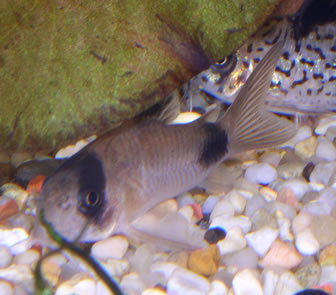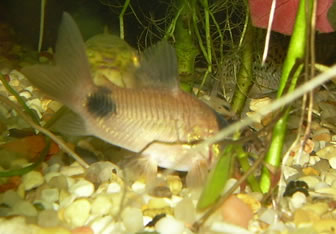Breeding Panda Catfish, Corydoras panda

Panda cory - Picture by Smaug
The “Panda Cat” (Corydoras panda) is a catfish found in the Ucayali river system of Peru. It is called Panda since it has black marking over its eyes. Black markings are also present on the dorsal fin and audal peduncle. The main body color is pink to orange. These fishes seldom grow bigger than 4.5 centimeters (1 ¾ inch).
Pairing
The recommended method of pairing Corydoras panda is to get a group of juveniles and let them grow up together. Panda cats are highly sociable creatures, so getting at least 4-6 specimens is recommended. This will also increase your chances of getting at least one of each sex. If you are lucky, you will even get several males. A group consisting of several males is more prone to spawn.
Housing Corydoras panda
A 10 gallon aquarium is sufficiently large to serve as breeding aquarium for Panda catfish. The aquarium should be well planted; you can for instance use Java moss and Amazon sword. Also give your Panda catfish at least one really sheltered place to rest in, e.g. a cave or a clay flower pot. If you want to raise egg and fry with their parents, ideally provide them with hiding spots by placing marbles on top of the substrate.
Water perimeters
The pH should be around neutral, but Corydoras panda tolerates everything from pH 6.0 to 8.0. The dH range for this species is dH 2-25, but if you want them to spawn you should ideally keep it under dH 10. The temperature should be in the upper part of its normal range (which is 20 – 25°C). A water temperature of 24-25°C is therefore recommended.
Conditioning and triggering
A nutritious diet is imperative if you want to breed Corydoras panda. Feed your catfish a varied diet with plenty of meaty foods. You can for instance combine black worms and brine shrimp with sinking catfish food and some high-quality flake food. Water changes are also imperative, ideally change 25% every fourth day. Frequent water changes are even more important if you feed your catfish black worms.
Spawning Corydoras panda
During spawning, the males will follow the fertile female around and circle her. The eggs are no larger than 1.5 mm and can be left on the glass as well as on plants and spawning mops. Unlike many other catfish species, Corydoras panda produce rather small batches. Don’t be surprised if the first Corydoras panda spawning yields less than 10 eggs.
Egg and fry raising
You can either leave the eggs with the parents or separate them from the adult fish. If you raise the offspring away from the parents, methylene blue can be used to prevent fungi.
 Panda cory - Picture av Smaug |
Egg and fry development
The eggs will hatch after 4-5 days if the water temperature is around 25ºC. At this point, the fry is no bigger than 6 mm and will seek out a sheltered place where they can stay until they grow bigger. It can take several weeks before they feel confident enough to swim around freely in the aquarium even if they have their own aquarium without any adult fish. Hints of the attractive panda pattern can be seen when they are no older than two weeks. After four weeks, they will be over 1 cm long and much thicker than when they hatched. At two months of age, Corydoras panda fry are normally at least 2 cm long.
Fry food
When the fry hatch, they will feed from their yolk sac for another 48 hours. Feeding is therefore unnecessary during the first two days. Microworms is a good first food for Corydoras panda fry. As they grow larger, you can start giving them newly hatched brine shrimp and then gradually increase the size of the brine shrimps.
Didn't find the info you were looking for? Register for free and ask your question in our Aquarium forum !
Our knowledgeable staff usually responds to any question within 24 hours
Related Articles
Breeding Corydoras, Brochis and Aspidoras catfish - Secrets to the successful breeding of Corydoras, Brochis or Aspidoras catfishAlbino Catfish - Information about Albino Catfish
Biggest Catfish ever caught - Information about which is the Biggest Catfish ever caught
Blue Catfish - Information about Blue Catfish
Breeding Bristlenose catfish - Ancistrus species - How to breed Ancistrus
Breeding Corydoras barbatus, Banded Corydoras / Bearded catfish - An introduction to the species and how to breed it.
Breeding Corydoras davidsandsi - A guide to successfully breeding C davidsandsi.
Breeding Corydoras elegans - How to breed this dwarf Corydoras
Breeding Corydoras gossei - Detailed guide on how to breed C. gossei.
Breeding Corydoras melanotaenia - Information about how to keep and breed C melanotaenia
Breeding Corydoras nattereri - Guide to breeding Corydoras nattereri
Breeding Corydoras xinguensis - Information about how to keep and breed this beautiful fish.
Breeding Whiptails - Information about how to breed different kinds of whiptails.
Channel Catfish - Information about Channel Catfish
Flathead Catfish - Information about Flathead Catfish
Giant Mekong Catfish - Information about Giant Mekong Catfish
Huge Catfish - Information about Huge Catfish
Tatia perugiae - Driftwood Catfish - Perugia's Woodcatfish - An article about tatia prugiae.
Monster Catfish - Information about Monster Catfish
Spawning Bristlenose Plecostamus (Ancistrus dolichopterus) - After months of inactivity, Twyla's Bristlenose Plecostamus finally decided to breed, and the eggs hatched.
Breeding Synodontis multipunctatus - cuckoo catfish - A guide to keeping and breeding S. multipunctatus aka "cuckoo catfish"..
Jaguar catfish (Liosomadoras oncinus) - Information about how to keep and care for the jaguar catfish.
Tiger Shovelnose Catfish - Information about Tiger Shovelnose Catfish
